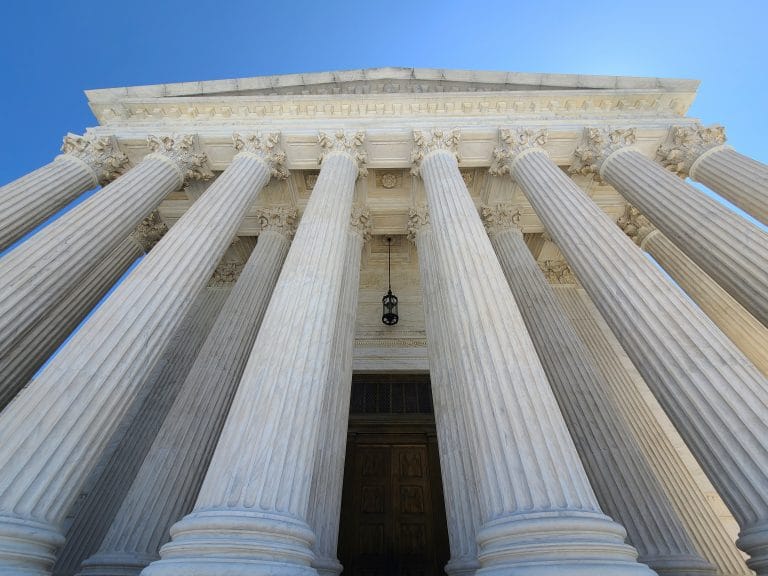The Supreme Court and New York are on an accelerating collision course.
Ever since the Court struck down the state’s “may-issue” gun-carry permitting law, which allowed officials to subjectively deny applicants in a way that violates the Second Amendment, lawmakers seem to have been pining for a rematch. After New York State Rifle and Pistol Association v. Bruen was handed down, they went straight to crafting a new batch of gun-carry restrictions. Those included a bevy of novel bans that seem almost purposefully designed to defy the Court’s decree.
“With this action, New York has sent a message to the rest of the country that we will not stand idly by and let the Supreme Court reverse years of sensible gun regulations,” Lieutenant Governor Antonio Delgado (D.) said in a statement after the bill’s passage.
While the state did not try to revive the invalidated standard for issuing permits that left it up to officials to decide whether an applicant had “proper cause” to carry a gun, nearly always finding they didn’t, it doubled down on a similar standard that leaves it up to officials to decide whether an applicant has a “good moral character.” New York also ignored the Court’s rejection of its argument that it could restrict gun carry in a myriad of “sensitive places” and instead added provisions that make it impossible to carry in most publicly-accessible areas. It also added new training requirements that go beyond what all other states have instituted to this point.
Now New York lawmakers may be getting the showdown they wished for. On Tuesday, Justice Sonya Sotomayor ordered the state to respond to an emergency motion by Gun Owners of America to rescind the stay issued by the Second Circuit on a lower court’s ruling in Antonyuk v. Nigrelli that blocked the law. The state has until January 3rd, 2023, to respond.
A mere six months after it decided Bruen, the Court is already dipping its toe back into the water.
That doesn’t necessarily mean the Court is about to cannonball back into Second Amendment litigation. In fact, Sotomayor could decide things herself. Given her opposition to Bruen, she’d likely side with New York on the stay. In that case, we’d learn little about what SCOTUS thinks of the law, and it would probably take several months (or even years) of litigation before the case made its way back to the Supreme Court.
But, if Sotomayor refers the decision to the full Court, it would likely discard the stay. That wouldn’t necessarily amount to a ruling on the merits. But it would give a lot of insight even if the Court doesn’t write anything at all explaining its decision.
After all, if the Court determines that the state’s restrictions are so burdensome on New Yorkers’ exercising their gun rights and removes the stay on the lower court decision to block most of them, it won’t be necessary to read tea leaves on where the case is ultimately headed. The Second Circuit could still defy the Court’s obvious intentions, and the Court may want the appellate court to further develop the record before issuing a detailed explanation of why it can’t stand.
But the outcome will doubtlessly be the same: New York’s most controversial restrictions won’t survive scrutiny.
The situation is starting to look like one of the most overlooked Second Amendment cases in Supreme Court history: 2016’s Caetano v. Massachusetts.
In that case, the Massachusetts Supreme Court upheld a state law banning stun guns because they didn’t exist at the time of the founding and aren’t useful for military service. This, the Court ruled, was a direct contradiction to what the High Court ruled in 2008’s Heller and 2010’s McDonald. Those cases established the Second Amendment protected both modern arms and non-military arms.
Caetano was a Per Curiam order. The Court considered the facts clear enough that it wrote only a few paragraphs noting its own previous rulings, and not one of the four liberal members on the Court at the time wrote a dissent.
Antonyuk may end up the same way. The Court already ruled in Bruen that subjective standards for gun-carry permits are unconstitutional, and the state can’t simply declare most everything a “sensitive place” as a workaround to try and ban lawful gun carry. Antonyuk offers the opportunity to dig into the various new restrictions if the Court wants. But it’s also set up well to give the justices an easy vacate-and-remand path if the Second Circuit upholds the limits.
It’s important to note, though, that very little post-Bruen litigation has made it past the district court stage at this point. The Court has been infamously slow to expand the Second Amendment caselaw to this point.
It has only been six months since Bruen. The justices didn’t rule in Caetano until six years after McDonald. The Court didn’t rule on the merits of another gun case for six years after Caetano either.
But there is good reason to think the era of slow Supreme Court action on Second Amendment litigation is over.
The balance of the Court has shifted since it began examining Second Amendment protections in 2008. After former President Donald Trump (R.) appointed Amy Coney Barrett to replace Ruth Bader Ginsburg in late 2020, the Court moved from five ostensibly pro-gun votes to six.
It’s still early, but the move has seemed to immediately affect how the Court approaches gun cases. In 2019, the Court took up a relatively minor gun case in New York State Rifle and Pistol Association v. City of New York. The case dealt with a novel law banning the transportation of unloaded guns to most locations, but the Court ruled it moot in early 2020 after the city repealed it to avoid losing.
However, instead of waiting for another five or six years to take another case, the Court went right back to the well. And, instead of picking another case dealing with a law on the fringes, it picked Bruen–a case on one of the most contentious gun issues.
Then it issued a landmark decision finding public gun-carry is protected by the Second Amendment and, even more consequentially, establishing a tough test for all future gun cases. That’s reason enough to think the Court may not be willing to wait very long to jump back into the deep end, especially when it comes to laws purpose designed to defy its judgments.







6 Responses
Given the current environment I am wondering if the blue states will simply ignore the court and write their unconstitutional laws anyway and then enforce them.
California, New York, New Jersey, and others are proposing and passing laws that defy the court’s rulings. I don’t have much faith that the Biden Administration will take action to force these states to comply.
I predict that there will be a constitutional crisis around this issue in 2023, and it will be centered around a standoff between the blue states and the Supreme Court and the Presidency will stand there and do nothing, further adding to division in the country.
I think it’s unlikely they will simply refuse to listen to the Supreme Court. It’s far more likely they’ll do what they did in this case, which is comply to what they think is the bare minimum amount and then push the boundaries that are left. They will likely have to be explicitly told what they’re doing is unconstitutional at each point.
Wow, what a waste of The People’s time and energy if the likely becomes true.
Indeed.
Thank you The Reload. Looking to go over to the 97Percent.org YouTube channel, see what you, Amy Swearer, Rob Pincus, any other pro-gun/pro-civil rights persons there have conversed on with the anti-gun moderates. And is CNN giving you their platform? On a consistent and “long-form” (for them, that is) basis?
I am a CNN contributor, yes. They invite me on as an analyst whenever they want to discuss gun issues.